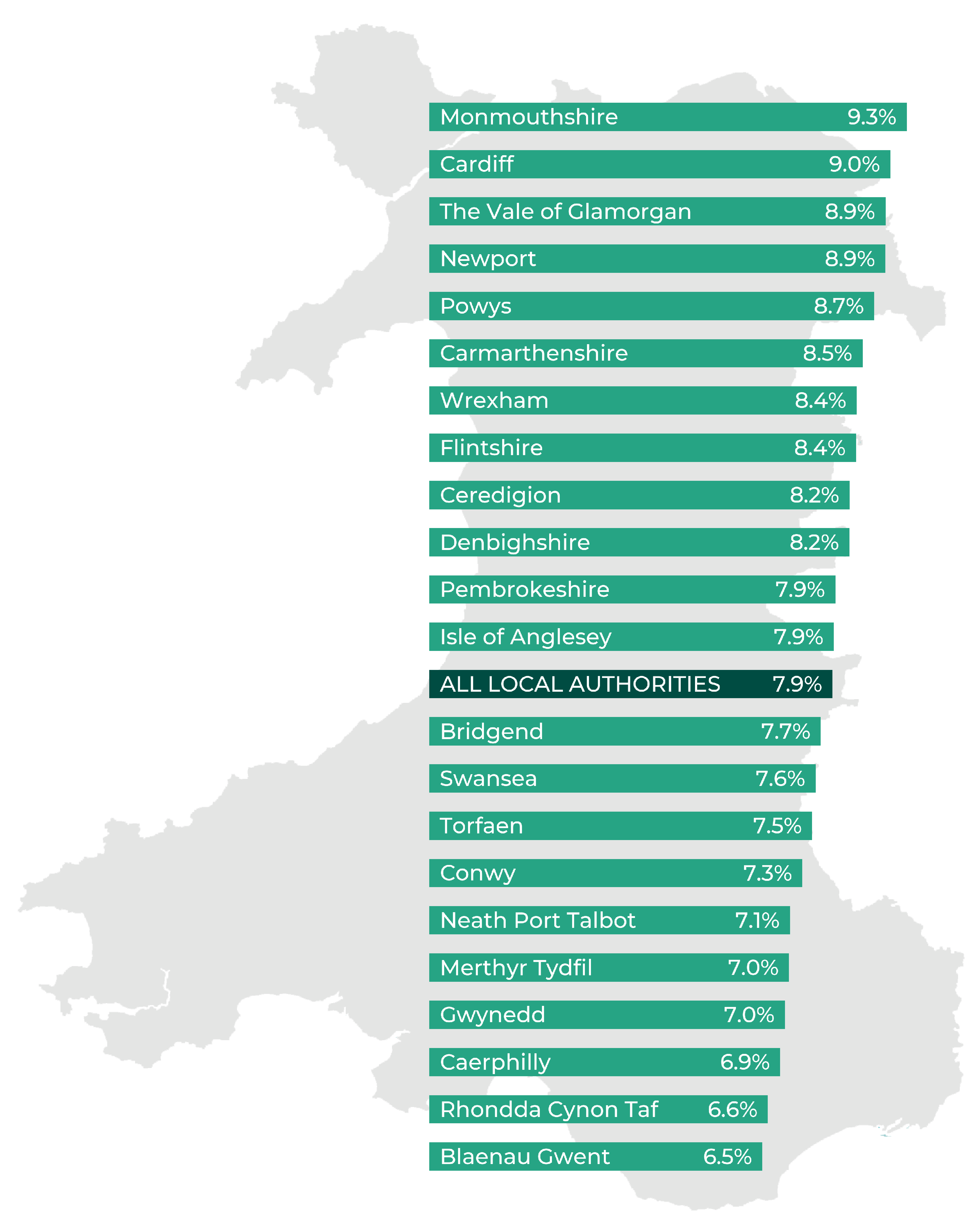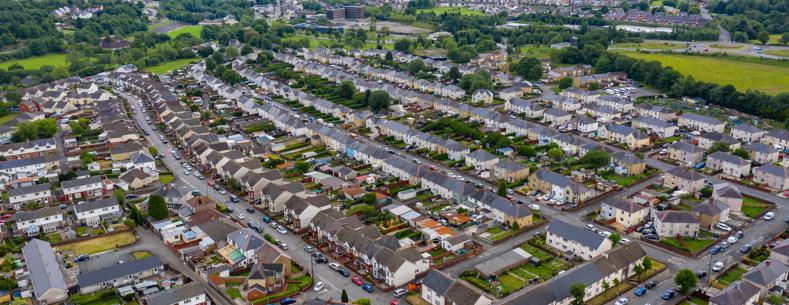On 14 December, the Welsh Government set out details of its funding for Wales’s 22 local authorities. At £5.5bn, the Minister for Finance and Local Government says it’s a “relatively good Settlement”, but recognises the significant pressure local authorities face. The Welsh Local Government Association (WLGA) welcomed the Settlement, but warned “tough decisions remain”.
In this article we take a look at the Provisional Local Government Settlement, the pressures facing local authorities and what this means for budgets next year. We also look at police funding for 2023-24, following publication of the Final Police Settlement 2023-24 at the end of January.
Core funding across local authorities will increase by 7.9%
Core revenue funding for the 22 local authorities (known as Aggregate External Finance or ‘AEF’) is provisionally set to rise from £5.1bn to £5.5bn on a like-for-like basis, an increase of around £400m or 7.9%. Within that, none of the 22 local authorities will receive an increase below 6.5%.
The allocations to local authorities are derived using a formula agreed with local government. The largest percentage increase this year is for Monmouthshire (9.3%) and the lowest for Blaenau Gwent (6.5%). For context, the overall increase for 2022-23 was 9.4%, and as is the case for 2023-24, Monmouthshire received the largest increase (11.2%) and Blaenau Gwent the lowest (8.4%).
Figure 1: Provisional change in AEF by local authority (2022-23 to 2023-24)

Source: Senedd Research and Welsh Government local government revenue and capital settlement 2023 to 2024
The Welsh Government says its overall budget is “made in hard times for hard times”. The Minister for Finance and Local Government (the ‘Minister’) says the Welsh Government has responded to “the need to support key front-line services”. It has identified the protection of frontline public services as one of its three “key investment pillars”, alongside continuing to help “those most impacted by the crises we face” and “supporting our economy through recessionary times”.
Looking further ahead, the Minister also sets out the equivalent indicative funding for 2024-25. Currently the Welsh Government intends to allocate £5.69bn, which would be an increase of £169m or 3.1% compared to the provisional settlement for 2023-24. However, that figure is based on current estimates of business rates and UK Government budgets – both of which could change.
Other funding available to local authorities
In addition to the core revenue funding for 2023-24, the Welsh Government outlined almost £1.4bn in specific grant funding (although this will likely be updated in the Final Settlement), for things like housing support or rates relief for businesses. It also detailed capital funding of almost £926m for 2023-24. This includes £180m in general capital funding for local authorities, which is around £30m more than 2022-23. The remaining capital funding is targeted at specific policy areas, such as ‘Sustainable Communities for Learning’ and the ‘Transforming Towns programme’.
Local authorities are also in the process of setting their own budgets for the upcoming financial year. This includes setting council tax levels.
“Huge” pressures in the system
Even with an increase of 7.9%, the Leader of Torfaen County Borough Council said it is inevitable there would be “reductions in service levels”. However, he also noted the Settlement gives local authorities “a fighting chance of meeting the gap without measures that will decimate the local services that people rely on”.
Prior to the Settlement being announced, the WLGA said all local authorities were reporting overspends in the current financial year (2022-23), and budget gaps in future years.
Before the Draft Budget being published, the WLGA estimated local authorities faced £784m of cumulative pressures by the end of 2023-24. It identified a further £439m of financial pressures in 2024-25. The ONS reports the Consumer Prices Index (CPI) rose by 10.5% in the 12 months to December 2022, and inflationary pressures will impact on local authority spending power. In addition the WLGA outline increased demands for local authority services and other budgetary pressures.
Over £256m of the financial pressures related to social care, which some stakeholders have described as a workforce in “crisis”. The Welsh Government’s Draft Budget includes additional funding to meet the Real Living Wage for social care workers, allocated through the Settlement and through funding for health and social services, which has been welcomed by the Association of Directors of Social Services (ADSS) Cymru. However, while ADSS Cymru say this will help with retention, it wasn’t seen as something that would have a huge impact on recruitment in the sector.
During scrutiny of the Draft Budget, the Leader of Isle of Anglesey County Council explained other local authority services were also experiencing issues with recruiting staff, and the WLGA outlined the pressure providers of commissioned services are coming under. Home to school transport was given as an example where contractors are “significantly increasing their costs”, with one authority receiving no bids to provide the service.
What about funding for police?
The Welsh Government also published its component of the Final Police Settlement for Wales 2023-24 in a process similar to that for local authorities. Next year, the four police forces will receive core funding of £434m, an increase of 0.3% compared to 2022-23, before adjustments.
Policing policy isn’t devolved and this funding is delivered through a three-way arrangement that means some funding comes via the Welsh Government, some through the UK Home Office and some via council tax.
In recent years, the Home Office has used a mechanism to ensure all police forces in England and Wales receive the same percentage change in funding each year. There have been discussions over the last few years around how funding is allocated to police, which is currently done through a Home Office formula. When asked in Parliament in January about a review of the formula, the Home Secretary said a consultation on police funding would begin “soon”.
In addition to UK and Welsh Government funding, Police and Crime Commissioners (PCCs) set a local police precept, which forms a part of overall council tax bills. For 2023-24, increases in that precept range from 5.14% (North Wales) to 7.75% (Dyfed-Powys). As with local authorities, Police and Crime Commissioners are in the process of setting their budgets for the forthcoming financial year.
When can I find out about the Final Settlement?
The Senedd debated the Welsh Government’s Draft Budget last week. The Finance Committee has already said, even with the increases in funding in the Draft Budget, “health, social care and local government all face difficult decisions about the services they provide in the coming year”. The Final Budget is due to be published on 28 February, and debated on 7 March. In the meantime, the Senedd will debate the Final Police Settlement on 14 February, which you can watch live on SeneddTV.
The Final Local Government Settlement is likely to be published and debated along the same timescales as the Welsh Government Final Budget.
The Minister said, while she can’t guarantee the Settlement won’t change between the provisional and final settlements, there wasn’t an intention to make any significant changes to the methodology or the data underpinning it, beyond those noted. Either way, it looks like there will be challenges for local authorities delivering services in 2023-24.
Article by Owen Holzinger and Joe Wilkes, Senedd Research, Welsh Parliament






